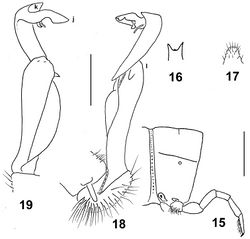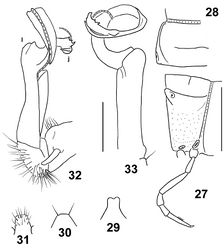Eustrongylosoma masalai
| Notice: | This page is derived from the original publication listed below, whose author(s) should always be credited. Further contributors may edit and improve the content of this page and, consequently, need to be credited as well (see page history). Any assessment of factual correctness requires a careful review of the original article as well as of subsequent contributions.
If you are uncertain whether your planned contribution is correct or not, we suggest that you use the associated discussion page instead of editing the page directly. This page should be cited as follows (rationale):
Citation formats to copy and paste
BibTeX: @article{Golovatch2011InternationalJournalofMyriapodology5, RIS/ Endnote: TY - JOUR Wikipedia/ Citizendium: <ref name="Golovatch2011International Journal of Myriapodology5">{{Citation See also the citation download page at the journal. |
Ordo: Polydesmida
Familia: Paradoxosomatidae
Genus: Eustrongylosoma
Name
Eustrongylosoma masalai Golovatch & Stoev, 2011 sp. n. – Wikispecies link – ZooBank link – Pensoft Profile
Type material
Holotype♂(NMNHS),Papua New Guinea, Western Province, Finim Tel area, October 1975, B.S.E. (leg. P. Beron). – Paratypes: 2 ♀(NMNHS), same locality, together with holotype.
Name
“masalai” means a “brownie” in Pidgin English. A noun in apposition.
Diagnosis
Distinguished by the rather narrow paratergal calluses, coupled with a missing colour pattern and a deeply split distal part of the solenophore (see also Key below).
Description
Length ca 18 (holotype) or 20 mm (paratypes), width of pro- and metazona 1.3 and 1.8 (holotype) or 1.7 and 2.0 mm (paratypes), respectively. Coloration uniformly castaneous brown to light brown; antennae light yellow-brown, legs yellow.
In width, head > collum = segments 5–17 < 2 < 3 = 4. Head densely setose, only vertex with 1+1 setae. Antennae rather short, slightly clavate, reaching beyond (♂) or end of segment 2 (♀) dorsally; antennomere 6 longer than 2nd. Collum transversely oval, lateral flaps small, regularly and broadly rounded. Tegument generally smooth and shining, only below paraterga faintly microgranulate; rear halves of metaterga sometimes faintly rugulose. Paraterga of postcollum segments moderately well developed (Figs 27, 28), set low (at about 1/3 midbody height), subhorizontal, evidently thicker in pore-bearing segments than in poreless ones; paratergum 2 with a small anterolateral denticle, its front margin straight; following paraterga without denticulations at lateral margin. Caudal corner of all postcollum paraterga rounded, slightly extended beyond rear tergal margin only in segments 2 and 17–19, better so in 18th. Lateral calluses of paraterga narrow, a little broader in pore-bearing segments, each delimited by a sulcus both dorsally and, in caudal 1/3, ventrally. Ozopores lateral, lying inside an ovoid groove. Tergal setae fully abraded, setation pattern untraceable. Axial line wanting. Transverse sulcus on metaterga rather superficial, far from reaching bases of paraterga, visible on metaterga 5–17, barely traceable also on 18th. Stricture between pro- and metazona rather faintly striolate. Pleurosternal carinae small, complete or nearly so in segments 2–5, a sharp or rounded caudal denticle retained also in segments 6 and 7, thereafter entirely missing. Epiproct (Fig. 29) short, flattened dorsoventrally, digitiform; apical papillae rather large, tip narrowly emarginate; subapical papillae missing. Hypoproct (Fig. 30) subtrapeziform, setigerous paramedian knobs at caudal margin well-separated and very small.
Sterna rather sparsely setose; a rather high, linguiform, caudally rounded, ventral, setose lamina only between ♂ coxae 4 (Fig. 31). Legs rather long and slender, midbody ones ca 1.5–1.6 (♂) or 1.1–1.2 (♀)times longer than body height, in ♂slightly incrassate compared to ♀; ♂tarsal brushes increasingly well reduced towards legs of segment 14.
Gonopods as in Figs 32 & 33. Tip (j) of a slender and coiled solenophore rather deeply biramous, larger branch bearing four apical or subapical denticles. Apicolateral lobe (l) of femorite relatively small.
Original Description
- Golovatch, S; Stoev, P; 2011: Review of the millipede genus Eustrongylosoma Silvestri, 1896 in the island of New Guinea, with descriptions of nine new species (Diplopoda, Polydesmida, Paradoxosomatidae) International Journal of Myriapodology, 5: 1-26. doi
Images
|

